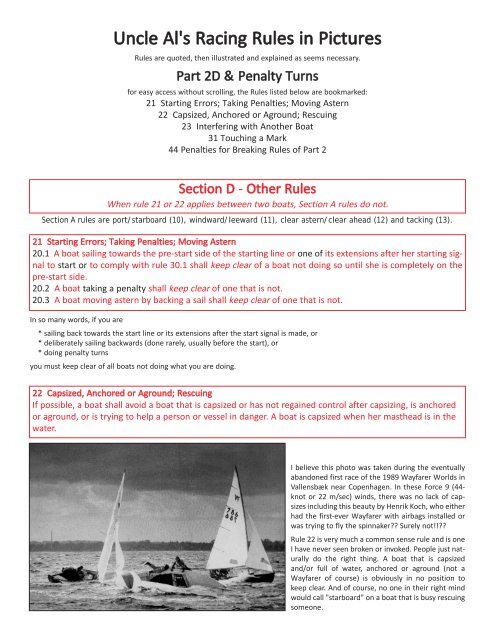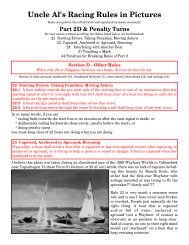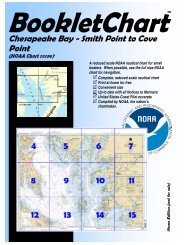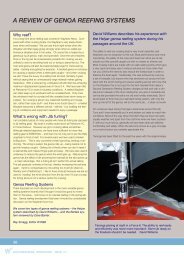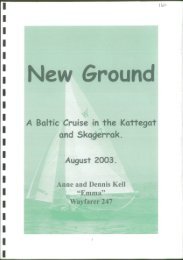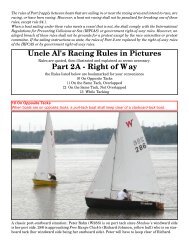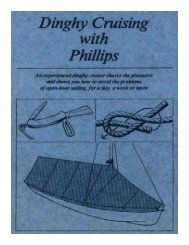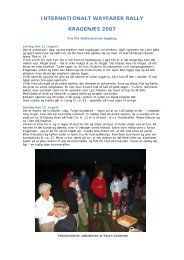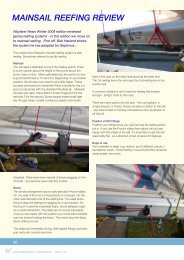Uncle Al's Racing Rules in Pictures
Uncle Al's Racing Rules in Pictures
Uncle Al's Racing Rules in Pictures
Create successful ePaper yourself
Turn your PDF publications into a flip-book with our unique Google optimized e-Paper software.
<strong>Uncle</strong> <strong>Al's</strong> <strong>Rac<strong>in</strong>g</strong> <strong>Rules</strong> <strong>in</strong> <strong>Pictures</strong><br />
<strong>Rules</strong> are quoted, then illustrated and expla<strong>in</strong>ed as seems necessary.<br />
Part 2D & Penalty Turns<br />
for easy access without scroll<strong>in</strong>g, the <strong>Rules</strong> listed below are bookmarked:<br />
21 Start<strong>in</strong>g Errors; Tak<strong>in</strong>g Penalties; Mov<strong>in</strong>g Astern<br />
22 Capsized, Anchored or Aground; Rescu<strong>in</strong>g<br />
23 Interfer<strong>in</strong>g with Another Boat<br />
31 Touch<strong>in</strong>g a Mark<br />
44 Penalties for Break<strong>in</strong>g <strong>Rules</strong> of Part 2<br />
Section D - Other <strong>Rules</strong><br />
When rule 21 or 22 applies between two boats, Section A rules do not.<br />
Section A rules are port/starboard (10), w<strong>in</strong>dward/leeward (11), clear astern/clear ahead (12) and tack<strong>in</strong>g (13).<br />
21 Start<strong>in</strong>g Errors; Tak<strong>in</strong>g Penalties; Mov<strong>in</strong>g Astern<br />
20.1 A boat sail<strong>in</strong>g towards the pre-start side of the start<strong>in</strong>g l<strong>in</strong>e or one of its extensions after her start<strong>in</strong>g signal<br />
to start or to comply with rule 30.1 shall keep clear of a boat not do<strong>in</strong>g so until she is completely on the<br />
pre-start side.<br />
20.2 A boat tak<strong>in</strong>g a penalty shall keep clear of one that is not.<br />
20.3 A boat mov<strong>in</strong>g astern by back<strong>in</strong>g a sail shall keep clear of one that is not.<br />
In so many words, if you are<br />
* sail<strong>in</strong>g back towards the start l<strong>in</strong>e or its extensions after the start signal is made, or<br />
* deliberately sail<strong>in</strong>g backwards (done rarely, usually before the start), or<br />
* do<strong>in</strong>g penalty turns<br />
you must keep clear of all boats not do<strong>in</strong>g what you are do<strong>in</strong>g.<br />
22 Capsized, Anchored or Aground; Rescu<strong>in</strong>g<br />
If possible, a boat shall avoid a boat that is capsized or has not rega<strong>in</strong>ed control after capsiz<strong>in</strong>g, is anchored<br />
or aground, or is try<strong>in</strong>g to help a person or vessel <strong>in</strong> danger. A boat is capsized when her masthead is <strong>in</strong> the<br />
water.<br />
I believe this photo was taken dur<strong>in</strong>g the eventually<br />
abandoned first race of the 1989 Wayfarer Worlds <strong>in</strong><br />
Vallensbæk near Copenhagen. In these Force 9 (44-<br />
knot or 22 m/sec) w<strong>in</strong>ds, there was no lack of capsizes<br />
<strong>in</strong>clud<strong>in</strong>g this beauty by Henrik Koch, who either<br />
had the first-ever Wayfarer with airbags <strong>in</strong>stalled or<br />
was try<strong>in</strong>g to fly the sp<strong>in</strong>naker?? Surely not!!??<br />
Rule 22 is very much a common sense rule and is one<br />
I have never seen broken or <strong>in</strong>voked. People just naturally<br />
do the right th<strong>in</strong>g. A boat that is capsized<br />
and/or full of water, anchored or aground (not a<br />
Wayfarer of course) is obviously <strong>in</strong> no position to<br />
keep clear. And of course, no one <strong>in</strong> their right m<strong>in</strong>d<br />
would call "starboard" on a boat that is busy rescu<strong>in</strong>g<br />
someone.
23 Interfer<strong>in</strong>g with Another Boat<br />
23.1 If reasonably possible, a boat not rac<strong>in</strong>g shall not <strong>in</strong>terfere with a boat that is rac<strong>in</strong>g.<br />
23.2 Except when sail<strong>in</strong>g her proper course, a boat shall not <strong>in</strong>terfere with a boat tak<strong>in</strong>g a penalty or sail<strong>in</strong>g<br />
on another leg.<br />
Rule 23 aga<strong>in</strong> is a matter of common sense:<br />
23.1: Obviously those still/already rac<strong>in</strong>g should be entitled to do so without <strong>in</strong>terference from boats not yet/no longer rac<strong>in</strong>g. In the<br />
photo above, Mike Murto (W2945) is tak<strong>in</strong>g a well-earned rest by heav<strong>in</strong>g to after s<strong>in</strong>gle-hand<strong>in</strong>g one of the 2003 Midw<strong>in</strong>ters races.<br />
In do<strong>in</strong>g so, he must be careful not to <strong>in</strong>terfere with any of the C Scows still complet<strong>in</strong>g their f<strong>in</strong>al beat.<br />
You are "<strong>in</strong>terfer<strong>in</strong>g" with another boat if you hit that boat or force it to change course. Tak<strong>in</strong>g another boat's w<strong>in</strong>d is not considered<br />
by the <strong>Rules</strong> to be "<strong>in</strong>terfer<strong>in</strong>g" (<strong>in</strong> the expert op<strong>in</strong>ion of Speed'n'Smarts author, Dave Dellenbaugh), but we will all do well to remember<br />
- start<strong>in</strong>g with <strong>Uncle</strong> Al himself!! - how annoyed we get when a bunch of guys who have f<strong>in</strong>ished, sometimes sit there block<strong>in</strong>g all<br />
our w<strong>in</strong>d while hav<strong>in</strong>g lunch right near the f<strong>in</strong>ish area. Even to take pictures, I now try to get well clear of boats still fight<strong>in</strong>g it out for<br />
f<strong>in</strong>ish positions!<br />
Note that 23.1 is a unique rule <strong>in</strong>sofar as there will be no penalty turns remedy available to you if you break 23.1 - because rule 44.1<br />
limits this remedy to rules of Part 2 broken "while rac<strong>in</strong>g"!!<br />
23.2: Aga<strong>in</strong>, the poor guy do<strong>in</strong>g a penalty already has enough troubles without anyone go<strong>in</strong>g out of their way to <strong>in</strong>terfere with the<br />
turn(s)!!
31 Touch<strong>in</strong>g a Mark<br />
While rac<strong>in</strong>g, a boat shall not touch a start<strong>in</strong>g mark before start<strong>in</strong>g, a mark that beg<strong>in</strong>s, bounds or ends the<br />
leg of the course on which she is sail<strong>in</strong>g, or a f<strong>in</strong>ish<strong>in</strong>g mark after f<strong>in</strong>ish<strong>in</strong>g.<br />
About 5 seconds before the start. John Cawthorne (W3654) ends up "sitt<strong>in</strong>g" too close to the favoured "p<strong>in</strong>" end, and is unable to<br />
get up enough speed to be able to "shoot" the mark without hitt<strong>in</strong>g it. <strong>Uncle</strong> Al (W6) oddly enough, starts off slightly to leeward of<br />
John but is already up to speed and will clear the mark (and John) with relative ease.<br />
After his brush with the mark, John can keep sail<strong>in</strong>g on starboard (tack<strong>in</strong>g would be risky here!!) and gybe to <strong>in</strong>itiate his penalty turn<br />
(see 44.2) as soon as there's no boats he'll <strong>in</strong>terfere with to leeward. Often, it will be possible (but not required!!) to just do the penalty<br />
turn right around the mark (as John did!). But he must then remember to end up go<strong>in</strong>g <strong>in</strong> the same direction as he is <strong>in</strong> the photo,<br />
i.e. he can't just gybe to port, harden up and sail away on port. That would not satisfy rule 44.2 (below) which requires a "complete<br />
turn <strong>in</strong>clud<strong>in</strong>g one tack and one gybe"!<br />
44 Penalties at the Time of an Incident<br />
44.1 Tak<strong>in</strong>g a Penalty<br />
A boat may take a Two-Turns Penalty when she may have broken a rule of Part 2 while rac<strong>in</strong>g or a One-Turn<br />
Penalty when she may have broken rule 31. Sail<strong>in</strong>g <strong>in</strong>structions may specify the use of the Scor<strong>in</strong>g Penalty or<br />
some other penalty. However,<br />
(a) when a boat may have broken a rule of Part 2 and rule 31 <strong>in</strong> the same <strong>in</strong>cident she need not take the penalty<br />
for break<strong>in</strong>g rule 31;<br />
(b) if the boat caused <strong>in</strong>jury or serious damage or ga<strong>in</strong>ed a significant advantage <strong>in</strong> the race or series by her<br />
breach her penalty shall be to retire.<br />
44.2 One-Turn and Two-Turns Penalties<br />
After gett<strong>in</strong>g well clear of other boats as soon after the <strong>in</strong>cident as possible, a boat takes a One-Turn or Two-<br />
Turns Penalty by promptly mak<strong>in</strong>g the required number of turns <strong>in</strong> the same direction, each turn <strong>in</strong>clud<strong>in</strong>g one<br />
tack and one gybe. When a boat takes the penalty at or near the f<strong>in</strong>ish<strong>in</strong>g l<strong>in</strong>e, she shall return completely to<br />
the course side of the l<strong>in</strong>e before f<strong>in</strong>ish<strong>in</strong>g.
Former rule 31.2 is now part of rule 44 (above). Pretty straightforward, this! You can (under most circumstances!) exonerate yourself<br />
for hitt<strong>in</strong>g a mark by do<strong>in</strong>g a prompt penalty turn - always remember<strong>in</strong>g that rule 21 requires you to keep clear of any boats not do<strong>in</strong>g<br />
turns. You can do the penalty turn by sail<strong>in</strong>g a circle around the mark or not - as you see fit - so long as the turn is done “as soon as<br />
possible”.<br />
If you hit a f<strong>in</strong>ish mark, you can also just gybe around it, tack back onto your orig<strong>in</strong>al tack on which you hit the mark, and f<strong>in</strong>ish. This<br />
takes care of the part which says "she shall sail completely to the course side of the l<strong>in</strong>e before f<strong>in</strong>ish<strong>in</strong>g".<br />
Note that rule 41.1(a) po<strong>in</strong>ts out that if a boat breaks "a rule of Part 2 and rule 31 <strong>in</strong> the same <strong>in</strong>cident she need not take the penalty<br />
for break<strong>in</strong>g rule 31". In so many words, one penalty per <strong>in</strong>cident is all you need to do.<br />
Instead of a picture (which I don't have and which wouldn't help very much!) may I suggest you do as I say not as I do: Don't get so<br />
upset - especially <strong>in</strong> a blow - at hav<strong>in</strong>g to do a turn or two, that you rip the boat around so fast and <strong>in</strong> such a rage that you capsize or<br />
swamp the boat (as I have done).<br />
Tip: Most people f<strong>in</strong>d it faster to gybe first (rather than tack<strong>in</strong>g) when <strong>in</strong>itiat<strong>in</strong>g a penalty turn.<br />
In my experience, we Wayfarers always seem to have the Two-Turns Penalty available to us - except of course if a foul causes <strong>in</strong>jury<br />
or serious damage. I have yet to see a situation where the "significant advantage" has applied. I suppose it would apply if a boat came<br />
<strong>in</strong> to the w<strong>in</strong>dward mark on port, faced an endless parade of starboard tackers and decided to butt <strong>in</strong> and take a penalty that might<br />
cost her a lot less than wait<strong>in</strong>g for 20 boats to go by?<br />
Three m<strong>in</strong>utes before the start. If Leif Trier Jensen (W8420, port<br />
tack) fouls Mogens Just (W4645) here, Leif can do a Two-Turns<br />
Penalty to exonerate himself (unless he caused <strong>in</strong>jury or serious<br />
damage). He can - must <strong>in</strong> fact - immediately sail well clear of all<br />
other boats and do his turns. With luck, he'll have the turns completed<br />
<strong>in</strong> time to still have a go at a good start.


